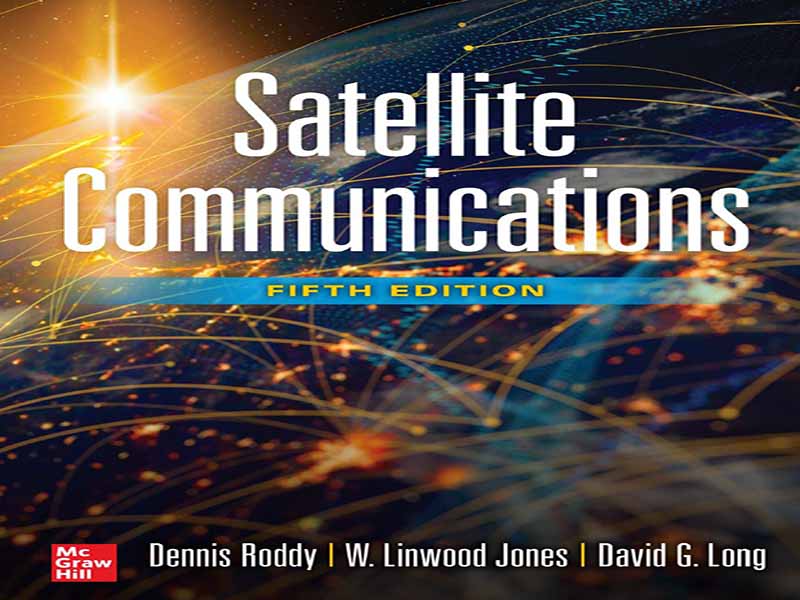- عنوان مجله: Satellite Communications, Fifth Edition
- نویسنده: Dennis Roddy
- حوزه: ارتباطات بیسیم
- سال انتشار: 2024
- تعداد صفحه: 1027
- زبان اصلی: انگلیسی
- نوع فایل: pdf
- حجم فایل: 38.5 مگابایت
مانند نسخه های قبلی، این کتاب درسی پوشش گسترده ای از ارتباطات ماهواره ای مدرن ارائه می دهد، اما با درگذشت پروفسور ممتاز دنیس رودی، این ویرایش پنجم به طور قابل توجهی توسط پروفسور W. Linwood Jones و David G. Long به روز شده است، که به طور جداگانه بیش از 40 سال تجربه در زمینه RF / مایکروویو تحقیقاتی، تحصیلات تکمیلی و تحقیقاتی رادیو و مایکروویو remo، تحصیلات تکمیلی رادیو و مایکروویو را دارند. حس کردن در مقایسه با نسخه چهارم، تغییرات قابل توجهی برای منعکس کردن انتقال سیستمهای ماهوارهای فعلی به ارتباطات دیجیتال و در عین حال حفظ ارائه سیستمهای قدیمی آنالوگ و دیجیتال در حال اجرا، ایجاد شده است. معرفی مواد جدید درک بهتر تحلیل پیوند ماهوارهای را با ارقام جدید و مثالهای عددی اضافه میکند. از 17 فصل، پنج باب، یعنی: فصل. 5- قطبی شدن، فصل. 8-بخش زمین، فصل. 9-سیگنال های آنالوگ، فصل. 11- کدگذاری کنترل خطا، و فصل. 16- تلویزیون پخش مستقیم ماهواره ای (DBS) اساساً بدون تغییر است. با این حال، 12 فصل باقی مانده به شرح زیر تجدید نظر شد: فصل 1 – مروری بر سیستم های ماهواره ای: به روز رسانی های پرتاب ماهواره های ارتباطی از سال 2000، و ارائه سیستم جستجو و نجات ماهواره ای فعلی را ارائه می دهد. فصل 2- مدارها و روشهای پرتاب: ارجاعات قدیمی به پرتاب ماهوارههای شاتل فضایی را حذف میکند، بحث پرتاب موشکهای قابل مصرف را گسترش میدهد، تقویتکنندههای مرحله اول قابل استفاده مجدد را معرفی میکند، و نمونههای عددی جدیدی از سناریوهای پرتاب GEO آورده شده است. فصل 3- مدار زمین ثابت: دو بخش جدید در مورد هندسه اشاره گر آنتن، با پنج مثال اضافی و دو مسئله تکلیف جدید معرفی شده است. فصل 4- انتشار امواج رادیویی: تأکید بیشتر بر اثرات جذب باران با سه بخش جدید و دو مسئله تکلیف جدید. فصل 6 – آنتن ها. سه بخش جدید در مورد محاسبه بهره دید آنتن ماهواره ای، پنج مثال جدید و پنج مشکل تکلیف جدید. فصل 7 – بخش فضایی: پنج بخش (شامل دو بخش جدید) را به روز کرد که بحث گسترده ای در مورد زیرسیستم ماهواره ای ارائه کرد و یک مشکل تکلیف خانه را اضافه کرد. فصل 10-سیگنال های دیجیتال: به روز شده و دامنه چهار بخش را با 10 شکل جدید و دو مثال جدید گسترش داد. فصل 12- پیوند فضایی: یک روش بهبودیافته برای درمان خسارات با تغییرات عمده در تمام بخشها، از جمله نه بخش جدید، 14 شکل جدید، هفت مثال جدید و سه مشکل تکلیف جدید معرفی کرد. فصل 13- تداخل: تغییرات جزئی با دو شکل جدید و یک مثال جدید. فصل 14-دسترسی ماهواره ای: روش به روز شده درمان ضررها، اضافه کردن پنج مثال عددی جدید و دو مسئله تکلیف جدید. فصل 15- ماهواره ها در شبکه ها: به روز رسانی عمده ارائه خدمات اینترنت ماهواره ای با اضافه شدن سه بخش جدید. فصل 17- خدمات تلفن همراه ماهواره ای و خدمات تخصصی: پنج بخش به روز شده برای حذف مطالب قدیمی و شامل خدمات مدرن SATCOM موبایل. دو پیوست G و H اضافه شد.
As with previous editions, this textbook provides a broad coverage of modern satellite communications, but with the passing of Professor Emeritus Dennis Roddy, this fifth edition has been significantly updated by Professors W. Linwood Jones and David G. Long, who individually have more than 40 years of experience in RF/microwave research and undergraduate and graduate education in satellite communications, radar, and microwave remote sensing. Compared to the fourth edition, significant changes have been made to reflect the transition of current satellite systems to digital communications, while maintaining the presentation of analog and digital legacy systems in operation. The introduction of new material promotes better understanding of satellite link analysis with many new figures and numerical examples added. Of the 17 chapters, five, namely: Chap. 5—Polarization, Chap. 8—The Earth Segment, Chap. 9—Analog Signals, Chap. 11—Error Control Coding, and Chap. 16— Direct Broadcast Satellite (DBS) Television, are essentially unchanged. However, the remaining 12 chapters were revised as follows: Chapter 1—Overview of Satellite Systems: provides updates to the communications satellite launches since 2000, and a presentation of the current satellite search and rescue system. Chapter 2—Orbits and Launching Methods: removes outdated references to Space Shuttle satellite launches, expands the discussion of expendable rocket launches, introduces reusable first-stage boosters, and new numerical examples of GEO launch scenarios are given. Chapter 3—The Geostationary Orbit: two new sections on antenna pointing geometry are introduced, with five additional examples and two new homework problems. Chapter 4—Radio Wave Propagation: Increased emphasis on rain absorption effects with three new sections and two new homework problems. Chapter 6—Antennas; three new sections concerning the calculation of satellite antenna line-of-sight gain, five new examples, and five new homework problems. Chapter 7—The Space Segment: updated five sections (including two new) giving expanded satellite subsystem discussion, and added one homework problem. Chapter 10—Digital Signals: updated and expanded the scope of four sections, with 10 new figures and two new examples. Chapter 12—The Space Link: introduced an improved method of treating losses with major changes to all sections, including nine new sections, 14 new figures, seven new examples, and three new homework problems. Chapter 13—Interference: minor changes with two new figures and one new example. Chapter 14—Satellite Access: updated method of treating losses, addition of five new numerical examples and two new homework problems. Chapter 15—Satellites in Networks: major update of presentation of satellite Internet services with three new sections added. Chapter 17—Satellite Mobile and Specialized Services: updated five sections to remove outdated material and to include modern mobile SATCOM services. Added two Appendices, G and H.
این کتاب را میتوانید از لینک زیر بصورت رایگان دانلود کنید:
Download: Satellite Communications, Fifth Edition





































نظرات کاربران